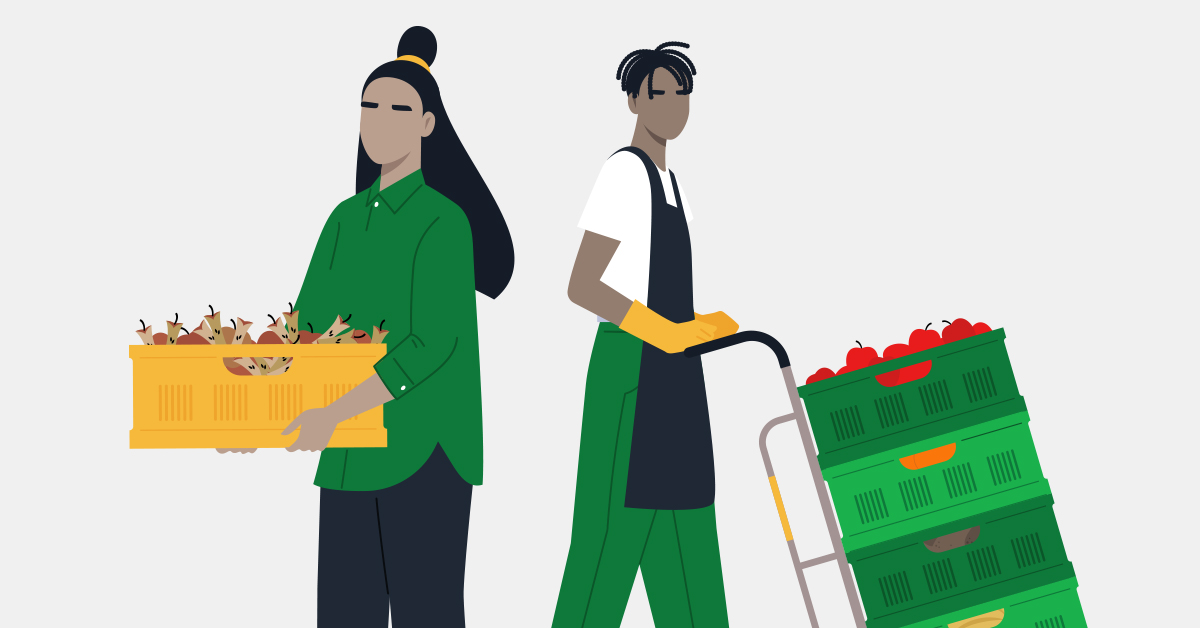
There’s a cost to making that delicious burger customers love, and it’s not reflected in the menu price.
Behind every dish, there’s a hidden and problematic environmental cost: food waste. Every day restaurants around the world handle a huge influx of food inventory. Unfortunately, to make sure customers get high-quality, fresh dishes, a lot of food ends up in the trash.
While waste isn’t a problem that’s easily solved, and there’s no one-size-fits-all approach, there are several measures a restaurant can take to reduce their environmental footprint. From refining your inventory management to getting creative with ingredients, these tips will help you take back control of your pantry and reduce your restaurant waste.
Find out the total cost of the dish, markup amount, profit per sale and how much to charge your customers.Calculate your food costs with our free food cost calculator.
Food waste in the restaurant industry
Many industries are responsible for food waste, but the restaurant industry undeniably takes the cake. Restaurants and food service providers generate two to four times more waste than grocery stores and wholesale distributors combined. This means that US restaurants generate 22 to 33 billion pounds of waste each year. This amount of waste is not something to ignore and something that gives restaurateurs and guests alike something to think about. A lot of this food waste can be attributed to issues in the planning stages and even menu management.
How food waste happens in restaurants
In the restaurant industry, waste can initially be split into two categories: pre-consumer and post-consumer. Pre-consumer waste takes place during the preparation process with food that doesn’t make it to the customer’s plate. This can happen when food is expired, overcooked or mishandled. Pre-consumer waste also includes food trimmings or food that has been sitting out too long. Post-consumer waste is essentially food that’s not consumed by the customer after it’s been served. This can be anything that’s left on their plate, but it can even be leftover takeout or delivery food that’s thrown out in the trash.
Analyzing restaurant waste
The first step towards reducing the amount of food and materials that end up in the trash is creating a food waste audit to analyze how much food you’re currently wasting, where and why. To start, take a look at waste in both the pre-consumer and post-consumer level, as the way to tackle these will be widely different.
If a lot of waste is happening on the pre-consumer level, this might mean you’ll need to invest more resources into inventory planning, operations, food temperature control or employee training.
When it comes to post-consumer waste control, you’ll look at portion sizes and things like menu descriptions. Restaurant patrons leave 17% of meals on their plate. Out of those leftovers, a whopping 55% gets left behind on the table. Is there a disconnect between the order description and what the customer actually receives? Are portion sizes too large? Is there a specific part of the dish that’s being consistently left behind? All of these factors can lead to high post-consumer waste.
Tips for starting a food waste audit
Waste will vary from restaurant to restaurant, but there are specific ways to keep track of what’s being wasted in your specific business. First choose a trial period that you will dedicate to calculating wastage. This can be as short as a week or as long as several months, depending on how busy your establishment is. Try starting out with a month trial to get enough information. During this month, instruct your staff to keep a log of everything that’s wasted and why.
To analyze pre-consumer waste, you can use separate trash cans or bins where staff can throw out waste in categories (expired, trimmings, overcooked, etc). This will give you a clear visual idea of how much waste you discarded that day for each specific category. For post-consumer waste, staff can track which dishes came back and which ingredients were left on the plate.
How to reduce restaurant waste
Reducing waste will involve making changes to different parts of your operations and will also require staff training and creative thinking.
These are some of the ways you can start reducing waste in your restaurant:
- Analyze and update your menu
- Start composting
- Reduce the use of disposables
- Plan ahead with automated inventory management
- Create a donation plan
Analyze and update your menu
Sometimes waste can come from unlikely sources, like what’s written out on your menu. Having a lengthy menu with very distinct items could mean that certain ingredients are being left unused. Based on your food waste audit, update your menu regularly to reflect what customers actually want. This doesn’t mean you need to cut out everything from your menu, but it will help you find synergies between the different ingredients and processes to create each menu item. Try to add dishes that use similar ingredients in completely different ways. This way, customers are still seeing interesting options, but there’s less waste during the preparation process.
Trimmings are another waste category for restaurants and these can be a great source of creativity for new menu items. You can use things like vegetable trimmings to make stock for a soup, or follow the example of Spring, a London restaurant that offers what they call a Scratch menu which uses restaurant waste to create new dishes. In their menu they use organic ingredients like beetroot tops and potato skins to make soups and also items like homemade pasta trimmings with leftover cheese. All of this highlights the importance of finding creative ways to make the most of every ingredient.
Using data to craft your menu
Your restaurant technology will play an important role in defining what to cut from your menu. By opting for a restaurant point of sale with in-depth analytics like Lightspeed’s Advanced Insights, you’ll get access to a detailed breakdown of your menu performance, and use guest’s behavior to figure out your best and underperforming dishes.
Start composting
Food waste will always be a part of running a restaurant, but that doesn’t mean you can’t transform your waste into something that’s useful for your restaurant or the planet.
Composting takes place when organic matter decomposes, forming a paste or fertilizer called compost. Compost can then be used to make soil or plants more fertile. If you have the space and time to do so, it’s definitely possible to compost in or outside your restaurant. For this you’ll need things like a closed bin (many companies offer specific containers for composting), soil and shovels. Keep your composting container somewhere your staff can access, but that’s away from your cooking station. The process can take several months to complete, but once it’s done you’ll have fertilizer that you can use in your restaurant garden or donate to other gardens or organizations. If you don’t want to compost on site, but still want to avoid sending your restaurant waste to landfills, you can contact a composting company near you or partner with a local agricultural organization
Reduce the use of disposables
Disposables are another form of waste in the pre and post-consumer process. Disposables can be anything from kitchen paper towels used while cleaning to the takeout containers customers bring home. While some coffee shops and restaurants already let customers bring their own containers to reduce waste—think reusable mugs or glass containers—it’s important to take a closer look at the amount and type of disposables restaurants have. However, with disposables (and all waste for that matter), the name of the game is reduce.
When ordering for delivery or takeout, give customers the option to opt out of receiving napkins or cutlery. Some restaurants even offer glass or steel containers for takeout, that customers can then bring back on their next visit.
A key step in reducing disposables is to avoid using single-use plastics such as straws, bags, containers and styrofoam materials. While biodegradables, often made from plants like corn and sugarcane pulp, are a popular alternative, it shouldn’t be the be all and end all solution. These alternatives still carry environmental impacts in their production that should be considered.
This is why, when possible, the best route is to reduce the use of all disposable materials as much as possible, and offer customers a way to participate in the reduction.
Plan ahead with automated inventory management
Planning is an essential step on the road to reducing restaurant waste. The amount of ingredients you’re ordering and the frequency will have a direct correlation with the amount of food that ends up in your trash cans during the pre-consumer process. Knowing how many ingredients to order and how often will take time to figure out, but mastering this process can also help you reduce costs.
In the past, restaurants would have to manually write up food logs to figure out their inventory process, but now technology streamlines this process. Modern-day inventory management software like Lightspeed Inventory, automates regular stock counting, giving restaurant owners more time to focus on actionable data to find concrete solutions to inventory problems. You can easily track how much inventory you’ve purchased, produced, wasted or sold and reduce waste by making more calculated orders. Better yet, Lightspeed Inventory also simplifies the process by offering real-time deductions as menu items are sold and replenishments when you receive a new inventory order.
Opting for inventory management that’s integrated in your POS will give you the data you need to make smarter decisions around inventory and better control over your operations.
Create a donation plan
Donating is a great way of giving back to the community while ensuring that your food doesn’t go to waste. While there are several regulations around donating food items, there are still many ways to put your food to good use.
Food that hasn’t expired, for example, can be donated to local food banks, pantries or rescue programs. While you can’t donate things like a half-eaten plate, you can donate meals to specific organizations. Humans aren’t the only ones who can benefit from donations. Food scraps and unused ingredients can also be donated to zoos and farms, as many use ingredients commonly used in food preparation to feed specific farm animals.
Before donating, make sure you’re following the rules and regulations of your region. Take a look at some resources below:
Reducing restaurant waste is a lifelong commitment
Reducing the amount of waste your restaurant produces is not a one-time project, but rather an ongoing process that needs to be incorporated into your overall restaurant operations. This will likely require changing your perspective around waste and finding creative ways to add it into your kitchen preparation, training employees and reevaluating everything you think you know about inventory management. While this might sound like a big undertaking, there’s nothing the restaurant industry likes more than a good challenge.
Ready to get started in your restaurant waste reduction journey? Talk to one of our experts to find out how Lightspeed can help.

News you care about. Tips you can use.
Everything your business needs to grow, delivered straight to your inbox.



